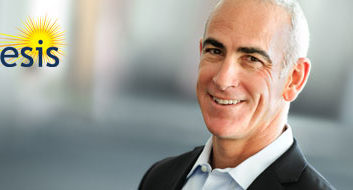Q&A: Steve McKay, CEO, DriveFactor – “The Key has been Flexibility”
Posted by | July 13, 2012
 After 11 years at Progressive Insurance, Steve McKay knew insurance inside and out, including many of the industry’s shortfalls. Steve realized that there were significant needs and opportunities in insurance and decided to become an entrepreneur. And so came about Crimson Informatics—recently rebranded as DriveFactor. The company aims to put personal data back in the hands of consumers and reduce car insurance costs for safer drivers.
After 11 years at Progressive Insurance, Steve McKay knew insurance inside and out, including many of the industry’s shortfalls. Steve realized that there were significant needs and opportunities in insurance and decided to become an entrepreneur. And so came about Crimson Informatics—recently rebranded as DriveFactor. The company aims to put personal data back in the hands of consumers and reduce car insurance costs for safer drivers.
Steve, the latest CEO to be featured in our partner company Q&A series, talks about how he became an entrepreneur, why he thinks flexibility is key for startups, and where DriveFactor is headed.
Why did you choose to become an entrepreneur?
I worked at Progressive Insurance for 11 years, until I saw a market need that could only be filled by becoming an entrepreneur. In a broad sense, there are two kinds of entrepreneurs: One kind says, “I would like to be an entrepreneur; I wonder what I should sell.” The other type says, “I found a big opportunity that really needs a different sort of energy to pursue.”
It had become increasingly clear in my corporate job that a world where each insurance company has a closed system was not going to work. There had to be a separate third party to build the right set of services for consumers and become a service provider to all our service companies. The time was right. I surveyed some people who would help in the enterprise, and so I went for it.
To what would you attribute your success?
I think the key has been flexibility. The specifics of the industry change a lot and are driven by all sorts of unpredictable factors, so it’s important to find employees, investors, buyers, and even customers that can be flexible. We look for employees who are smart enough and creative enough to thrive as things change, because the business will change.
One example that comes to mind is that when I started the company, we never thought we would be involved in designing hardware. We were just going to use a third party. But it turned out that that third party couldn’t provide what we wanted, and so we did it ourselves (it was actually easier than we thought).
What’s the most important lesson you’ve learned as an entrepreneur?
Every stakeholder has a slightly different set of intentions and desires. And your strategy has to satisfy each of those. That is, it’s not as if one sort of success satisfies everybody. Everybody has a slightly different set of motivations for doing what they’re doing and you have to keep all of those in mind.
Different employees have slightly different motivations for doing their sort of work. Investors have different motivations. And it’s not that everyone isn’t aligned. It’s just that the path between here and, say, becoming the next Facebook, really is different. You have to keep all of those motivations in mind and make sure that everything you’re doing is optimizing across all those different desires.
What’s your biggest business challenge right now?
The biggest challenge has been predicting how large companies will proceed. I can see the direction technology is going, the direction the market is going, and what an organization’s end state will be. But which particular large customers will get there first? And what will be important to them?
It’s also been tricky to figure out who wants what variation of the product. We’re constantly customizing what we’re offering and can modify it company to company. And that puts a significant operational burden on us. So we’ve had to focus what we’re selling. We’ve had to turn down opportunities that are just too far afield, and we’ve had to be disciplined about securing which combinations of things in the overall product are going to be the most successful in the end.
What advice would you give other entrepreneurs in similar industries to DriveFactor?
What’s driving opportunity is hardware. That’s where change has been very, very fast. It’s been remarkably responsive to what consumers need and that’s what’s creating the cascading effect for other changes in financial services and insurance.
Nobody in telematics invented the iPhone. But it turns out that changes in the iPhone have a significant downstream effect in the way that telematics will work and the interactions that consumers have, especially regarding privacy.
As those interactions evolve, they’ll have important effects on expectations for consumers and how they interact with telematics and insurance. So that is incredibly important to us.
As much as you might say “I’m an insurance or financial services sector guy, not a technology product manager,” that’s what we all have to be since it’s creating so much disruption in our area too.
How do you operate at DriveFactor? How do you motivate your team? What’s the culture like?
I would describe the culture as highly creative and investigative. We put a premium on developing novel solutions for problems. That doesn’t mean we want to invent everything ourselves, but the whole area is so new that we need to support everyone as we brainstorm new ways to attack things. I think that ideally leads to a culture that is simultaneously low-key and hyper-intense.
Because we have so much flexibility, it’s not a world where we can penalize people for minor deviations. We’re still investing in the future, so we need a lot of collegial support. But at the same time, the stakes are really high, so everybody has to be behind the notion that there are no second chances for a lot that we do. So I would call it low-key but hyper-intense, with a high premium on creativity and elegant solutions to the problem.
What is your long-term vision for telematics and auto-insurance?
The long term vision is to create—and for DriveFactor to create—the largest database of driving behavior. We want to connect that database, either on our own or through third parties, directly to consumers in a way that gives them control over their privacy and how their data is used. We want to provide that data to insurance companies in a way that allows them to give consumers benefits in the form of low rates. That’s the key vision.
The secondary piece of that is to focus our analysis on changing behavior. So not just ranking people based on their driving data but proving that there are ways of motivating people to change how they drive, even just a little, because that’s so valuable, not just to insurance companies, but also to society more broadly.
What should startups look for in VCs beyond just the financing? What core services are most important for startups? What do startups tend not to think about?
VC culture matters way more than I would have thought. Some VCs—you can tell in the first five minutes—are thinking about how they can squeeze another dime out of you. And every time you talk to them, they’ve got a new idea, and it’s that they’ve found a way to squeeze another dime.
But there’s another class of VCs, into which I would put Safeguard, that’s much more interested in how a company can build value. Every time I talk to the people at Safeguard, the conversation is “Hey, I’m trying to think of another way to make the pie bigger.”
Which is not to say that you don’t have an interest in the size of the slice you get, but it’s a much more productive relationship to be thinking about operations and what you can do. How can you organize better? How can you reduce healthcare costs? How can you hire better talent?
I think the second thing that’s important is the goals: Are they long term or short term? Are your goals aligned? Some VCs are trying to establish particular reputations in particular sectors, and sometimes you’ll find VCs whose interests overlap with yours, but not very broadly. So those are the two things that matter quite a lot: the VC’s culture and its particular strategic goals.
What’s your go-to news source?
On the predictable front, I like both The New York Times and The Washington Post. I like the Washington Post’s business and technology reporting. For news sources in the telematics world, there are 2 or 3 key people at trade publications who turn out to be in the middle of everything.
And going back to my prior point about technology being key to what we do, I also read the consumer technology blogs, particularly Gizmodo. They give you a big window into where things are likely to go, and the fact that they’re consumer-oriented gives you a clear sense of what needs are out there to be satisfied.
What’s your must-have app?
Well, I have to mention the not-yet-released DriveFactor mobile app, which we hope will become everyone’s favorite, not just for telematics, but for a broad range of driving-oriented applications.
But I would have to say Dropbox, because I can put everything in there and easily access it. I particularly like the ability to pull things up and display them to third parties, so as we’re working on mobile developments, I can use Dropbox to show screen shots on your phone and that’s really cool.
For more information about DriveFactor, please visit the company’s website (www.drivefactor.com) or follow it on Twitter (@drive_factor).
Read more in our Q&A Series with Safeguard Scientifics’ partner company CEOs.



